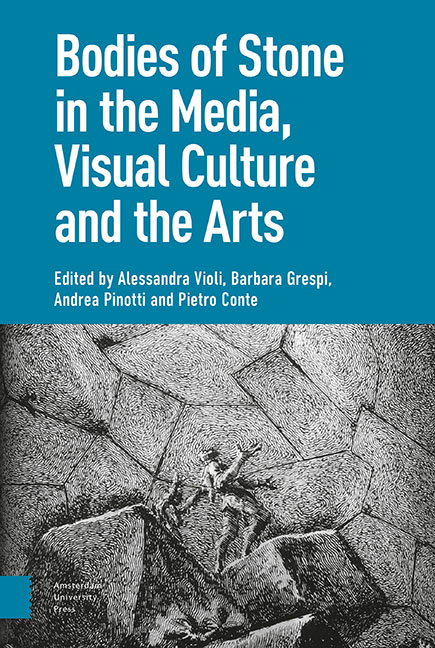Book contents
- Frontmatter
- Contents
- Introduction: Learning from Stone
- I Statue: The Imaginary of Uncertain Petrification
- 1 Theatre and Memory: The Body-as-Statue in Early Modern Culture
- 2 Translated Bodies: A ‘Cartographic’ Approach
- 3 Pantomime in Stone: Performance of the Pose and Animal Camouflage
- 4 Animated Statues and Petrified Bodies: A Journey Inside Fantasy Cinema
- 5 The Ephemeral Cathedral: Bodies of Stone and Configurations of Film
- II Matter: Size, Hardness, Duration
- 1 Bodies That Matter: Miniaturisation and the Origin(s) of ‘Art’
- 2 Brancusi’s ‘Sculpture for the Blind’
- 3 Cinema, Phenomenology and Hyperrealism
- 4 Ephemeral Bodies: The ‘Candles’ of Urs Fischer
- 5 The Celluloid and the Death Mask: Bazin’s and Eisenstein’s Image Anthropology
- III Corpse: Fossils, Auto-Icons, Revenants
- 1 Funeral Eulogy: Post-Mortem Figures and Redeemed Bodies, in Images
- 2 On Jack Torrance As a Fossil Form
- 3 Technical Images and the Transformation of Matter in Eighteenth-Century Tuscany
- 4 Glass, Mixed Media, Stone: The Bodily Stuffs of Suspended Animation
- 5 Bodies’ Strange Stories: Les Revenants and The Leftovers
- IV Monument: Embodying and Grafting
- 1 The Impassibly Fleshly, the Statue of the Impossible
- 2 Frozen into Allegory: Cleopatra’s Cultural Survival
- 3 The Orphan Image
- 4 The Well-Tempered Memorial: Abstraction, Anthropomorphism, Embodiment
- 5 Monuments of the Heart: Living Tombs and Organic Memories in Contemporary Culture
- Index
1 - The Impassibly Fleshly, the Statue of the Impossible
Published online by Cambridge University Press: 20 November 2020
- Frontmatter
- Contents
- Introduction: Learning from Stone
- I Statue: The Imaginary of Uncertain Petrification
- 1 Theatre and Memory: The Body-as-Statue in Early Modern Culture
- 2 Translated Bodies: A ‘Cartographic’ Approach
- 3 Pantomime in Stone: Performance of the Pose and Animal Camouflage
- 4 Animated Statues and Petrified Bodies: A Journey Inside Fantasy Cinema
- 5 The Ephemeral Cathedral: Bodies of Stone and Configurations of Film
- II Matter: Size, Hardness, Duration
- 1 Bodies That Matter: Miniaturisation and the Origin(s) of ‘Art’
- 2 Brancusi’s ‘Sculpture for the Blind’
- 3 Cinema, Phenomenology and Hyperrealism
- 4 Ephemeral Bodies: The ‘Candles’ of Urs Fischer
- 5 The Celluloid and the Death Mask: Bazin’s and Eisenstein’s Image Anthropology
- III Corpse: Fossils, Auto-Icons, Revenants
- 1 Funeral Eulogy: Post-Mortem Figures and Redeemed Bodies, in Images
- 2 On Jack Torrance As a Fossil Form
- 3 Technical Images and the Transformation of Matter in Eighteenth-Century Tuscany
- 4 Glass, Mixed Media, Stone: The Bodily Stuffs of Suspended Animation
- 5 Bodies’ Strange Stories: Les Revenants and The Leftovers
- IV Monument: Embodying and Grafting
- 1 The Impassibly Fleshly, the Statue of the Impossible
- 2 Frozen into Allegory: Cleopatra’s Cultural Survival
- 3 The Orphan Image
- 4 The Well-Tempered Memorial: Abstraction, Anthropomorphism, Embodiment
- 5 Monuments of the Heart: Living Tombs and Organic Memories in Contemporary Culture
- Index
Summary
Abstract
According to phenomenology, existence is an incarnate subjectivation which frees, by perceiving and imagining, the ‘Self’ from its petrification. Autobiography is a fiction pretending to repair this vitality, to represent the irrevocable future instant of death by images and words and to record the past as an irremediable destiny. To write the singular own existence is thus to make up a monumentalisation of the living being, fixed as a statue and fascinating as an idol, a death mask or a mummy. In the 1940s, Sartre, Lévinas, Blanchot and Bataille discussed Baudelaire, Proust and Leiris to challenge Heidegger's existentialism and ontology of art. The essay examines this crucial debate—interdisciplinary, intertextual and intermedial—about literature and philosophy, picture, magic and death.
Keywords: Georges Bataille; Maurice Blanchot; Emmanuel Levinas; Jean-Paul Sartre; philosophy of literature; aesthetics of sculpture
It will be with stones that I will vindicate myself.
‒ Leiris‘At the bottom of sensation there is a corporeity, […] a liberation of the subject from his own petrification as subject, […] a freedom that undoes the structure.’ ‘The word “I”, summarizes for me the structure of the world.’ The first quotation is from Emmanuel Levinas, a philosopher of the phenomenological school, and alludes to Husserl; the second is from Michel Leiris, a surrealist writer and ethnologist, a friend of Sartre's and Bataille’s. Moving between philosophy and literature and over the course of a few years, I will follow the relation between subjectivisation and petrification and the way it affects imagination, the images of art, and death.
To perceive, Lévinas tells us, is not to represent but to transcend, to go out of oneself and beyond the given, to join one's own body to the flesh of the world. Perception is actionin potency and an emancipation of the subject from the mere passionof sensation, in which the ‘aesthetic effect’ of a material image is merely undergone like an anaesthetic that renders the subject insensitive, feelingless and indifferent. Embodied in a lived experience and in individual imagination, perception is, however, transformed into an image by the subject, which becomes such only through the other-than-himself and through the recounting of his own existence. For Sartre, the imagination produces ‘some petrifiable image’ of a past that has been shaped a posteriorias ‘unalterable and imperishable’, like a statue.
- Type
- Chapter
- Information
- Bodies of Stone in the Media, Visual Culture and the Arts , pp. 295 - 304Publisher: Amsterdam University PressPrint publication year: 2020

